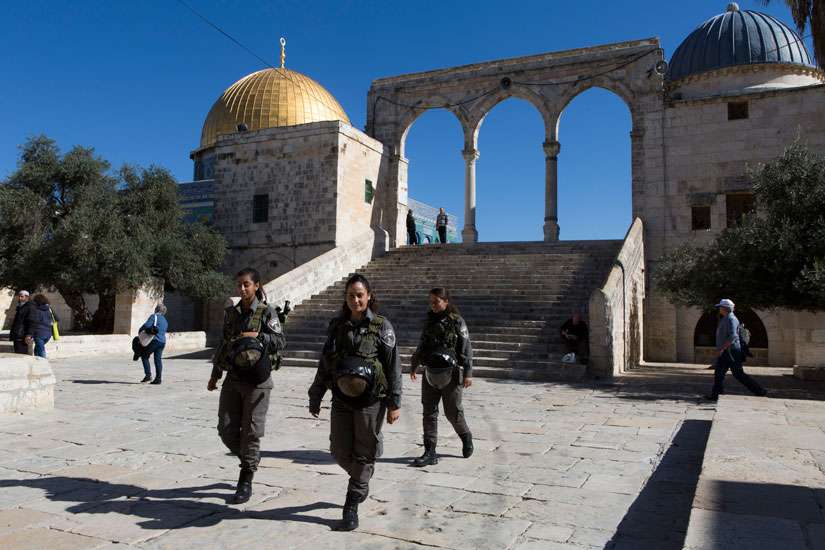These days, the Temple Mount — known as the Haram al-Sharif to Muslims — is at the centre of an intense debate over messianic religious Zionism. How Israeli society deals with it may hold the key to the peace process.
Temple Mount tensions were sparked by last month’s attempted assassination of U.S.-born Rabbi Yehuda Glick, who was seriously wounded. Glick is a fierce advocate for building a third Jewish temple on the site of the Temple Mount, where two Jewish temples stood thousands of years ago. He is also at the forefront of a campaign to allow Jewish prayers at the site. Israel currently bans Jews from praying on the plateau to prevent clashes with Muslims worshipping at the nearby Noble Sanctuary, a mosque considered to be Islam’s third-holiest site, and Jerusalem’s most iconic gold-domed landmark.
A Palestinian shot Glick four times in the chest after a seminar at the state-sponsored Menachem Begin Heritage Centre in Jerusalem. As Glick fights for his life, Israelis and Palestinians ramped up violence and traded recriminations over whether he and like-minded activists are responsible for the clashes.
Prime Minister Benjamin Netanyahu has blamed “terrorists” for the clashes over Temple Mount. On Nov. 10, he ordered his security Cabinet to increase the number of security forces on the ground and move forward on the demolition of “terrorists’ homes.”
The next day, Palestinian President Mahmoud Abbas, speaking in Ramallah at a speech marking the 10th anniversary of the death of former PLO leader Yasser Arafat, said Israel’s settlement policies and actions at the Temple Mount have led to a “detrimental religious war.”
That “war” has driven rifts in the Jewish community, too.
After the assassination attempt, Deputy Knesset Speaker Moshe Feiglin went to the Temple Mount, ignoring Netanyahu’s call for restraint, and vowed to “change the reality” of a ban on Jewish prayer at the site.
Later, speaking at the funeral of a teenage victim of a Palestinian attack at a Jerusalem light rail station last week, Chief Rabbi Yitzhak Yosef lashed out against politically motivated visits to the site.
“We need to stop the incitement provoked by people going to the Temple Mount,” said Yosef, according to Israeli news site Ynet.
Motti Inbari, a religion professor at the University of North Carolina at Pembroke, worries about the increasingly open popular campaign to build a third temple — a proposal that would fan the flames of hatred against Jews around the Middle East.
Inbari noted how advocates of a third temple recently posted a video on Facebook and YouTube that uses computer-generated graphics to illustrate a reconstructed shrine on the Temple Mount. The video then links to an Indiegogo crowdfunding campaign that has generated $104,814 toward the construction of the temple.
In the video, “you don’t see any mosques on the Mount,” said Inbari, who specializes in studying fundamentalist movements. “The clip suggests that the temple replaces the mosques on the Mount. This can explain why Muslims are nervous.”
Inbari said Temple Mount activists mobilized financial and political support in Israel, particularly through the Temple Institute, a Jerusalem-based non-profit dedicated to rebuilding the temple.
“The Temple Institute is supported with millions of shekels by the state every year,” he said. “They get money from the Ministry of Religious Affairs and the Education Ministry, and even the Ministry of Immigrant Absorption is giving them money, so it is already part of the mainstream being supported by the state.”
The tensions have sparked concerns in Jordan, too. Jordan is the official guardian of the Noble Sanctuary and other Islamic institutions in Jerusalem according to the 1994 peace treaty with Israel.
Jordan withdrew its ambassador from Tel Aviv last week after Israeli police instituted closures at the Al-Aqsa Mosque, a few steps away from the Noble Sanctuary.
Reflecting the views of many Muslims in the region, Wasfi Kailani, director of the Jordanian Hashemite Fund for the Restoration of Al-Aqsa Mosque and the Dome of the Rock, the two buildings that make up the Noble Sanctuary, said Glick and his compatriots are dangerous.
“It’s good for Israel and it’s good for Jordan not to go too far in ideological goals of speeding up the messiah and God’s will on Earth because this is not different actually from the thinking of the Islamic State of Syria and the Levant.”
The Islamic State declared a new Muslim caliphate this summer after gaining a large swath of territory in the region.
Just how influential Glick and other third-temple enthusiasts are is a bone of contention. Several lawmakers from Netanyahu’s ruling coalition were in attendance at the seminar where Glick had been speaking before he was shot. And after being removed from a respirator, Glick called Knesset Speaker Yuli-Yoel Edelstein, a member of Netanyahu’s Likud party, according to Israel’s Channel 7 web site.
But Mordechai Kedar, an Arabic language lecturer at Bar-Ilan University in Tel Aviv, rejected the idea that Temple Mount activists were influential or violent.
“I know Yehuda Glick — he’s one of a handful of lunatics who represent nobody but themselves,” said Kedar.
Kedar insists the Palestinian leadership has provoked the crisis in Jerusalem. He slammed Abbas for sending a condolence letter to the family of the suspect in Glick’s shooting, who was killed by Israeli police after the attack.
“The Temple Mount activists are not violent,” he said. “They are not going to kill anybody … unlike those thugs. They just work on the Jewish right to pray at the Temple Mount. Did Yehuda Glick attack somebody?”


